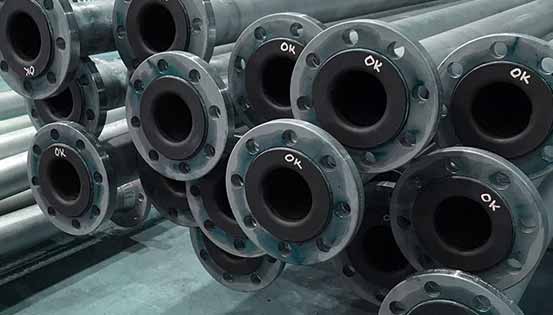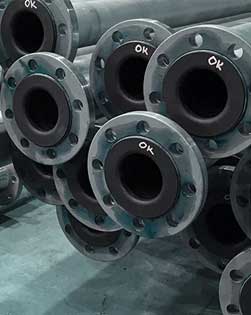22 April 2011- Rubber Lining is a procedure which is done
to provide protection against corrosion and abrasion in industrial setting,
especially where chemicals, acids etc. are used as well as where the
materials have to withstand high temperature, water or other such conditions
that can affect them badly. Various types of rubber
lining are used for different purposes. Rubber lining application, is
however, a specialist process that has to be carried out by rubber lining
specialists only otherwise their purpose is not met. Many rubber lining
companies therefore flourish in almost every part of the world. These may
include the rubber lining manufacturers as well as the rubber lining
services (the firms that actually conduct on site rubber lining application
through their hired specialists) who have partnerships with the
manufacturers and suppliers of rubber linings. However, what this article is
focusing on is the actual procedure conducted by the rubber lining
specialists for the application of rubber linings.
Rubber Lining Services
Rubber Lining Application by Specialist Services
Specialist rubber lining services offer a variety of pre-vulcanized and post-vulcanized rubber lining application depending upon on the work conditions and area of application. For this, all the items to be lined are inspected to find the suitability for rubber lining. They are then shot or sand blasted. After blasting, cleaning is done and a suitable rubber primer is applied immediately. Then the rubber is cut and scarfed. The lining is then carried out by slatted liners and cured with steam in an open steaming or autoclave with hot water or with live steam. The rubber lining is then tested with the help of high voltage spark testing machine both pre-cured and post-cured.Detailed Rubber Lining Procedure
Following is the step by step detailed procedure for rubber lining application carried out by rubber lining specialist services.Fabrication
Whenever, rubber lining has to be done, all the metal parts to be rubber lined are fabricated without sharp corners. Welding is done on all seams in areas to be lined. All imperfections including sharp edges, porosity, pinholes, undercutting, slag pockets etc. are taken care of.Inspection and Cleaning
The part where rubber lining has to be applied is first inspected for suitability of rubber lining and dimensional correctness. The surface is also inspected before sandblasting for any such condition as grease, oil, dirt, rust and other contaminants. All these matters are removed through buffing, burning or washing with solvent.

Surface Preparation
All the surfaces where rubber lining has to be done are sandblasted to get a clean gray white metal surface so that there is a proper metal to rubber bond. Many rubber lining services then inspect once again the blasted metal for proper anchor pattern depth.Primer Application
After the sand blasting is completed, priming begins within a maximum of four hours. Consistent cement is applied to give a smooth, uniform coverage to the surface. After application of cement, the surface is not exposed to sunlight or weather. Cement is allowed to dry for sufficient time so that it forms a dry or tacky film.Rubber Lining Application
Rubber Lining Application After all the preparation, the actual application of rubber lining begins. The appropriate rubber lining selected for the surface is cut to the required size and shape. Some specialists apply an appropriate adhesive or sealant just after the surface had dried after applying primer. Some other rubber lining specialists coat one side of the rubber lining with tack cement and apply it to the blasted and cemented surface.In the first case, the rubber lining that has been cut is laid into position on the adhesive-coated surface. Usually, here the rubber is non-elastic and can be given desired shapes around irregular contours of the surface. Then the rubber is rolled out to tightly bond the rubber lining sheets to the metal. In the other case also, after coating the rubber lining material, it is rolled down using steady and firm overlapping strokes with a roller. Care is always taken not to stretch or apply tension to the rubber lining. The rolling of lining begins in the center of the lining material and is worked toward the edges. This removes any air out from behind the lining and makes sure that a proper bond is achieved. Rubber linings are then seamed together, if required, with the help of either skive butt joints or lap joints. All seams are offset later.
Curing
After the rubber lining is applied, the un-vulcanized rubber linings are vulcanized or cured for proper adhesion to the metal surface. For this, one of the various methods can be adopted including - autoclave cure; internal pressure cure; exhaust, or atmospheric, steam cure; hot water cure; or chemical cure. The selection of curing process depends upon the composition of the rubber lining and the size of the vessel.Pre Cure and Post Cure Inspection
A rubber lining specialist, who is an expert in the subject, always does pre-cure and post cure inspection. For pre cure testing, the rubber linings are inspected visually for proper adhesion and loose joints; blisters (trapped air), pulls, or surface defects. The rubber linings are spark tested also with the help of a properly calibrated spark tester to locate any pin-holes leaks.For post cure testing also, the rubber linings are inspected on the same criteria as for pre cure inspection. There is an additional check done here by many rubber lining services- the durometer check which uses a properly calibrated durometer gauge to make sure that the rubber is cured as per the specification.
RELATED ARTICLES
- Anti Vibration Mountings
- Automobile Rubber Products
- Calendered Rubber Products
- Extruded Rubber Products
- Medical Rubber Products
- Metal Bonded Components
- Rubber Adhesives & Sealants
- Rubber Ball
- Rubber Bands
- Rubber Beading
- Rubber Bearing
- Rubber Belt
- Rubber Buckets
- Rubber Bullets
- Rubber Cable
- Rubber Coating
- Rubber Duct
- Rubber Expansion Joints
- Rubber Flooring/Matting
- Rubber Footwear
- Rubber Gloves
- Rubber Injection Parts
- Rubber Lining
- Rubber Magnets
- Rubber Molded Products
- Rubber Pads
- Rubber Rollers
- Rubber Stopper
- Rubber Suit
- Rubber Track
- Rubber Valve
- Rubber Balloon
- Rubber Stamps
- Rubber Fenders
- Acrylic Rubber (ACM)
- Butadiene Rubber (BR)
- Butyl Rubber (IIR)
- Chlorosulfonated Polyethylene(CSM)/ Hypalon
- Ethylene Propylene Diene Monomer
- Fluoroelastomers (FKM)/Viton
- Isoprene Rubber (IR)
- Nitrile Rubber (NBR)
- Perfluoroelastomer (FFKM)
- Polychloroprene (CR)/Neoprene
- Polysulfide Rubber (PSR)
- Silicone Rubber (SiR)
- Styrene Butadiene Rubber
How to Make a Custom Rubber Stamp?
Whenever designing a custom stamp for your company, never compromise on its quality because in the end it is the most...
Read MoreLatex and Silicone Rubber Tubing - A Comparison!
Many industries use rubber tubing for various purposes. In fact, various types of rubber tubing are used for different applications...
Read MoreSilicone vs Acrylic Adhesive- A Comparison
Silicon and acrylic adhesives are those rubber adhesives that are widely used in Polyimide tapes. In fact, the polyimide...
Read More

